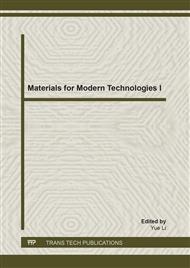[1]
N. Rendtorff, G. Suárez, Y. Bruni, et al, Thermal shock behavior of zircon based refractories, Adv. Sci. Technol. 70 (2011) 59-64.
Google Scholar
[2]
Q. Li, S. Dong, Wang Z, et al, Fabrication and properties of 3-D Cf/SiC-ZrC composites, using ZrC precursor and polycarbosilane, J. Am. Ceram. Soc. 95 (2012) 1216-1219.
DOI: 10.1111/j.1551-2916.2012.05116.x
Google Scholar
[3]
J. Liu, J.F. Huang, L.Y. Cao, et al, ZrSiO4/SiC oxidation protective coating for Carbon/Carbon composites prepared by hydrothermal electrophoretic deposition, Key. Eng. Mater. 512 (2012) 1070-1073.
DOI: 10.4028/www.scientific.net/kem.512-515.1070
Google Scholar
[4]
W.H. Kong, J.F. Huang, C.Y. Li, et al. Microstructure analysis and preparation of B2O3-modified ZrSiO4/SiC oxidation resistant coatings. Mater. Sci. Forum. 80 (2015).
Google Scholar
[5]
M. Ritala, Kuklik, A. Rahtu, et al, Atomic layer deposition of oxide thin films with metal alkoxides as oxygen sources. Sci. 288 (2000) 319-321.
DOI: 10.1126/science.288.5464.319
Google Scholar
[6]
J. Morais, E.B.O. da Rosa, Miotti L, et al, Stability of zirconium silicate films on Si under vacuum and O2 annealing. Appl. Phys. Lett. 78 (2001) 2446.
DOI: 10.1063/1.1367288
Google Scholar
[7]
S. Zürcher, M. Morstein, N.D. Spencer, et al, New single-source precursors for the MOCVD of high-κ dielectric zirconium silicates to replace SiO2 in semiconducting devices. Chem. Vap. Desposition. 8 (2002) 171-177.
DOI: 10.1002/1521-3862(20020704)8:4<171::aid-cvde171>3.0.co;2-z
Google Scholar
[8]
W.J. Qi, R. Nieh, E. Dharmarajan, et al, Ultrathin zirconium silicate film with good thermal stability for alternative gate dielectric application. Appl. Phys. Lett. 77 (2000) 1704.
DOI: 10.1063/1.1308535
Google Scholar
[9]
L.M. Manocha, S.M. Manocha, Studies on solution-derived ceramic coatings for oxidation protection of carbon-carbon composites. Carbon. 33 (1995) 435-440.
DOI: 10.1016/0008-6223(94)00168-y
Google Scholar
[10]
K. Bouchmella, P. Hubert Mutin, M. Stoyanova, et al, Olefin metathesis with mesoporous rhenium-silicium-aluminum mixed oxides obtained via a one-step non-hydrolytic sol-gel route. J. Catal. 301 (2013) 233-241.
DOI: 10.1016/j.jcat.2013.02.016
Google Scholar
[11]
X.Y. Xu, W.H. Jiang, T. Chen, et al, Preparation of C@ ZrSiO4 inclusion pigment using compound colorants via non-hydrolytic sol-gel method. Adv. Mater. Res. 936 (2014) 170-175.
DOI: 10.4028/www.scientific.net/amr.936.170
Google Scholar
[12]
H.B. Chen, C.X. Xu, Electric property of nanostructural ZnO fabricated on silicon substrate. Chin. J. Electron. Devices. 4 (2009) 729-732.
Google Scholar
[13]
D.G. Chen, Anti-reflection (AR) coatings made by sol–gel processes: A review. Sol. Energy. Mater. Sol. Cells. 68 (2001) 313-336.
DOI: 10.1016/s0927-0248(00)00365-2
Google Scholar
[14]
C.J. Brinker, A.J. Hurd, P.R. Schunk, et al, Review of sol-gel thin film formation. J. Non-Cryst. Solids. 147–148 (1992) 424-436.
DOI: 10.1016/s0022-3093(05)80653-2
Google Scholar


